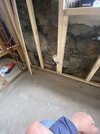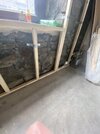- Joined
- 18 Apr 2024
- Messages
- 4
- Reaction score
- 0
- Country

Hi,
Just wondering is anyone can provide some advice.
I am renovating a stone built terrace which has rising damp on the front external wall.
I have had the outside repointed as it was blown.
On the inside, I have drilled holes and installed dry rods. However, the dry rods have NOT dissolved.
I am not completely surprised by this, because the mortar for the bottom 1ft had turned into a mud like material, which I suspected wasn’t the best for dry rods.
Is there a solution for this?? Would DPC cream work better or do I need to repoint internally?
I have also built a stud wall internally which I am going to insulate and board. There is a 1/2 inch gap between the new stud and the solid wall.
As I have installed a second skin, is there a need to treat the rising damp on the outer skin?
Help appreciated.
Photos below.
Just wondering is anyone can provide some advice.
I am renovating a stone built terrace which has rising damp on the front external wall.
I have had the outside repointed as it was blown.
On the inside, I have drilled holes and installed dry rods. However, the dry rods have NOT dissolved.
I am not completely surprised by this, because the mortar for the bottom 1ft had turned into a mud like material, which I suspected wasn’t the best for dry rods.
Is there a solution for this?? Would DPC cream work better or do I need to repoint internally?
I have also built a stud wall internally which I am going to insulate and board. There is a 1/2 inch gap between the new stud and the solid wall.
As I have installed a second skin, is there a need to treat the rising damp on the outer skin?
Help appreciated.
Photos below.



